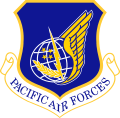History
At the beginning of the Korean War, the United States Air Force's only tactical control group was the 502d at Pope Air Force Base, North Carolina. To respond, Fifth Air Force organized the 6132d Tactical Air Control Squadron, which established a full-scale Tactical Air Control Center at Taegu Air Base, South Korea on 23 July 1950.
Less than three months later, the 502nd and its subordinate squadrons moved from Pope to Korea. Elements left behind at Pope by the 502d were used to form the 507th Tactical Control Group there. [2] In October 1950 the 502d replaced the 6132nd TCS in the mission of directing tactical air operations in Korea. Through its 605th Tactical Control Squadron, the group operated the Tactical Air Control Center and worked with the United States Army in a Joint Operations Center. The group's two aircraft control and warning squadrons operated Tactical Air Direction Centers, which used stationary and mobile radar and communications equipment to guide aircraft on close air support missions. [1] In November a third aircraft control and warning squadron was activated to reinforce the group.
The group also deployed Tactical Air Control Parties, which accompanied ground units to communicate with strike aircraft. These small detachments followed advancing U.S. and allied troops into North Korea in October and November 1950, but the Chinese Communist offensive soon overran several of them. The 502d TCG's headquarters and the Tactical Air Control Center, which had been operating from Seoul in November and part of December, were forced to return to Taegu. [1]
After deployment to the Korean War, in January 1951, the three AN/MPQ-2 radars of the 3903rd Radar Bomb Scoring Group RBS detachments were transferred to the operational control of the 502nd TCG. The MPQ-2 radars guided Martin B-26 Marauders against enemy positions in front of the 25th Infantry Division." [4] On February 23, 1951, the first Boeing B-29 Superfortress mission controlled by an MPQ-2 was flown. [5]
During the spring and summer of 1951, the 502d directed night bombing of enemy targets, including troop concentrations, supply dumps, and motor convoys. As United Nations ground forces drove the enemy back across the 38th Parallel, the group returned to Seoul in June, along with the Tactical Air Control Center and the Joint Operations Center returned to Seoul. In October, the 502nd set up a communications station 100 miles behind enemy lines on Cho-do Island, three miles off the North Korean coast. [note 1] From this location the detachment guided fighter aircraft against enemy airplanes in MiG Alley, bombers against strategic targets along the Yalu River, and search and rescue aircraft toward survivors who had ditched at sea.
On 6 June 1952, the 502nd was instrumental in the destruction of nine Mikoyan-Gurevich MiG-15 aircraft by directing North American F-86 Sabres to maneuver into a position from which they could advantageously attack the MiGs. In addition, during 1952, Detachment 2 of the 608th Squadron was credited with the first (and possibly the only) confirmed kill of a multi-engine enemy bomber. The following month, the 502nd guided warplanes in attacks on enemy troop formations that blunted communist offensives until the Korean Armistice Agreement was signed in July 1953. [1]
This page is based on this
Wikipedia article Text is available under the
CC BY-SA 4.0 license; additional terms may apply.
Images, videos and audio are available under their respective licenses.





